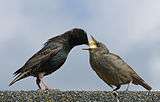Scavenger
Scavengers are animals that consume dead organisms that have died from causes other than predation.[1] While scavenging generally refers to carnivores feeding on carrion, it is also a herbivorous feeding behavior.[2] Scavengers play an important role in the ecosystem by consuming dead animal and plant material. Decomposers and detritivores complete this process, by consuming the remains left by scavengers.
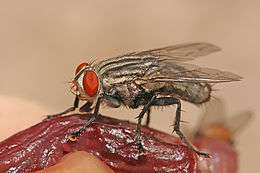
Scavengers aid in overcoming fluctuations of food resources in the environment.[3] The process and rate of scavenging is affected by both biotic and abiotic factors, such as carcass size, habitat, temperature, and seasons.[4]
Etymology
Scavenger is an alteration of scavager, from Middle English skawager meaning "customs collector", from skawage meaning "customs", from Old North French escauwage meaning "inspection", from schauwer meaning "to inspect", of Germanic origin; akin to Old English scēawian and German schauen meaning "to look at", and modern English "show" (with semantic drift).
Types of scavengers
Obligate scavenging is rare among vertebrates, due to the difficulty of finding enough carrion without expending too much energy.
Well-known invertebrate scavengers of animal material include burying beetles and blowflies, which are obligate scavengers, and yellowjackets. Fly larvae are also common scavengers for organic materials at the bottom of freshwater bodies. For example, Tokunagayusurika akamusi is a species of midge fly whose larvae live as obligate scavengers at the bottom of lakes and whose adults almost never feed and only live up to a few weeks.
Most scavenging animals are facultative scavengers that gain most of their food through other methods, especially predation. Many large carnivores that hunt regularly, such as hyenas and jackals, but also animals rarely thought of as scavengers, such as African lions, leopards, and wolves will scavenge if given the chance. They may also use their size and ferocity to intimidate the original hunters (the cheetah is a notable victim, rather than a perpetrator). Almost all scavengers above insect size are predators and will hunt if not enough carrion is available, as few ecosystems provide enough dead animals year-round to keep its scavengers fed on that alone. Scavenging wild dogs and crows frequently exploit roadkill.
Scavengers of dead plant material include termites that build nests in grasslands and then collect dead plant material for consumption within the nest. The interaction between scavenging animals and humans is seen today most commonly in suburban settings with animals such as opossums, polecats and raccoons. In some African towns and villages, scavenging from hyenas is also common.
In the prehistoric eras, the species Tyrannosaurus rex may have been an apex predator, preying upon hadrosaurs, ceratopsians, and possibly juvenile sauropods,[5] although some experts have suggested the dinosaur was primarily a scavenger. The debate about whether Tyrannosaurus was an apex predator or scavenger was among the longest ongoing feuds in paleontology; however, most scientists now agree that Tyrannosaurus was an opportunistic carnivore, acting mostly as a predator but scavenging when it could.[6] Recent research also shows that while an adult Tyrannosaurus rex would energetically gain little though scavenging, smaller theropods of approximately 500 kg (1,100 lb) may have potentially gained levels similar to that of hyenas, though not enough for them to rely on scavenging.[7] There are also an info that Otodus megalodon, Ceratosaurus, Andrewsarchus and some more prehistoric animals were scavengers. Animals which consume feces, such as dung beetles, are referred to as coprovores. Animals that collect small particles of dead organic material of both animal and plant origin are referred to as detritivores.
Ecological function
Scavengers play a fundamental role in the environment through the removal of decaying organisms, serving as a natural sanitation service.[8] While microscopic and invertebrate decomposers break down dead organisms into simple organic matter which are used by nearby autotrophs, scavengers help conserve energy and nutrients obtained from carrion within the upper trophic levels, and are able to disperse the energy and nutrients farther away from the site of the carrion than decomposers.[9]
Scavenging unites animals which normally would not come into contact,[10] and results in the formation of highly structured and complex communities which engage in nonrandom interactions.[11] Scavenging communities function in the redistribution of energy obtained from carcasses and reducing diseases associated with decomposition. Oftentimes, scavenger communities differ in consistency due to carcass size and carcass types, as well as by seasonal effects as consequence of differing invertebrate and microbial activity.[4]
Competition for carrion results in the inclusion or exclusion of certain scavengers from access to carrion, shaping the scavenger community. When carrion decomposes at a slower rate during cooler seasons, competitions between scavengers decrease, while the number of scavenger species present increases.[4]
Alterations in scavenging communities may result in drastic changes to the scavenging community in general, reduce ecosystem services and have detrimental effects on animal and humans.[11] The reintroduction of gray wolves (Canis lupus) into Yellowstone National Park in the United States caused drastic changes to the prevalent scavenging community, resulting in the provision of carrion to many mammalian and avian species.[4] Likewise, the reduction of vulture species in India lead to the increase of opportunistic species such as feral dogs and rats. The presence of both species at carcasses resulted in the increase of diseases such as rabies and bubonic plague in wildlife and livestock, as feral dogs and rats are transmitters of such diseases. Furthermore, the decline of vulture populations in India has been linked to the increased rates of anthrax in humans due to the handling and ingestion of infected livestock carcasses. An increase of disease transmission has been observed in mammalian scavengers in Kenya due to the decrease in vulture populations in the area, as the decrease in vulture populations resulted in an increase of the number of mammalian scavengers at a given carcass along with the time spent at a carcass.[8]
Disease transmission
Scavenging may provide a direct and indirect method for transmitting disease between animals. Scavengers of infected carcasses may become hosts for certain pathogens and consequently vectors of disease themselves. An example of this phenomenon is the increased transmission of tuberculosis observed when scavengers engage in eating infected carcasses.[12] Likewise, the ingestion of bat carcasses infected with rabies by striped skunks (Mephitis mephitis) resulted in increased infection of these organisms with the virus.
A major vector of transmission of diseases are various bird species, with outbreak being influenced by such carrier birds and their environment. An avian cholera outbreak from 2006 to 2007 off the coast Newfoundland, Canada resulted in the mortality of many marine bird species. The transmission, perpetuation and spread of the outbreak was mainly restricted to gull species who scavenge for food in the area.[13] Similarly, an increase of transmission of avian influenza virus to chickens by domestic ducks from Indonesian farms permitted to scavenge surrounding areas was observed in 2007. The scavenging of ducks in rice paddy fields in particular resulted in increased contact with other bird species feeding on leftover rice, which may have contributed to increased infection and transmission of the avian influenza virus. The domestic ducks may not have demonstrated symptoms of infection themselves, though were observed to excrete high concentrations of the avian influenza virus.[14]
Threats
Many species that scavenge face persecution globally. Vultures, in particular, have faced incredible persecution and threats by humans. Before its ban by regional governments in 2006, the veterinary drug Diclofenac has resulted in at least a 95% decline of Gyps vultures in Asia. Habitat loss and food shortage have contributed to the decline of vulture species in West Africa due to the growing human population and overhunting of vulture food sources, as well as changes in livestock husbandry. Poisoning certain predators to increase the number of game animals is still a common hunting practice in Europe and contributes to the poisoning of vultures when they consume the carcasses of poisoned predators.[8]
Benefits to human well-being
Highly efficient scavengers, also known as dominant or apex-scavengers, can have benefits to human well being. Increases in dominant scavenger populations, such as vultures, can reduce populations of smaller opportunistic scavengers, such as rats.[15] These smaller scavengers are often pests and disease vectors.
In humans
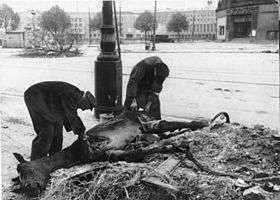
In the 1970s Lewis Binford suggested that early humans primarily obtained meat via scavenging, not through hunting.[16] In 2010, Dennis Bramble and Daniel Lieberman proposed that early carnivorous human ancestors subsequently developed long-distance running behaviors which improved the ability to scavenge and hunt: they could reach scavenging sites more quickly and also pursue a single animal until it could be safely killed at close range due to exhaustion and hyperthermia.[17]
In modern humans, necrophagy (eating of dead/decaying flesh) occurs rarely in most societies. Many instances have occurred in history, especially in times of war, where necrophagy and cannibalism can emerge as a survival behavior.
Gallery
- White-backed vultures feeding on a carcass of a wildebeest
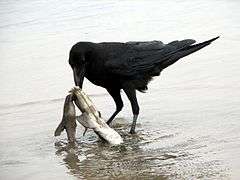 A jungle crow feeding on a small dead shark
A jungle crow feeding on a small dead shark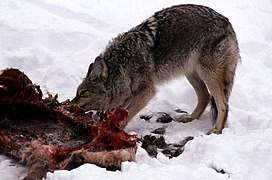
_scavenging_a_narwhal_whale_(Monodon_monoceros)_carcass_-_journal.pone.0060797.g001-A.png) A polar bear scavenging on a narwhal carcass
A polar bear scavenging on a narwhal carcass_scavenging_on_fish_scraps_leftover_from_another_predator_-_journal.pone.0060797.g001-B.png) An Ibiza wall lizard scavenging on fish scraps left over from another predator
An Ibiza wall lizard scavenging on fish scraps left over from another predator_feeding_on_a_dead_African_giant_snail_(Achatina_fulica)_-_journal.pone.0060797.g001-F.png) Red weaver ants feeding on a dead giant African snail
Red weaver ants feeding on a dead giant African snail
See also
- Consumer-resource systems
References
- TAN, CEDRIC K. W.; CORLETT, RICHARD T. (2011-03-30). "Scavenging of dead invertebrates along an urbanisation gradient in Singapore". Insect Conservation and Diversity. 5 (2): 138–145. doi:10.1111/j.1752-4598.2011.00143.x. ISSN 1752-458X.
- Getz, W (2011). "Biomass transformation webs provide a unified approach to consumer–resource modelling". Ecology Letters. 14 (2): 113–124. doi:10.1111/j.1461-0248.2010.01566.x. PMC 3032891. PMID 21199247.
- Castilla, A.M.; Richer, R.; Herrel, A.; Conkey, A.A.T.; Tribuna, J.; Al-Thani, M. (July 2011). "First evidence of scavenging behaviour in the herbivorous lizard Uromastyx aegyptia microlepis". Journal of Arid Environments. 75 (7): 671–673. Bibcode:2011JArEn..75..671C. doi:10.1016/j.jaridenv.2011.02.005. ISSN 0140-1963.
- Turner, Kelsey L.; Abernethy, Erin F.; Conner, L. Mike; Rhodes, Olin E.; Beasley, James C. (September 2017). "Abiotic and biotic factors modulate carrion fate and vertebrate scavenging communities". Ecology. 98 (9): 2413–2424. doi:10.1002/ecy.1930. ISSN 0012-9658. PMID 28628191.
- Switeck, Brian (April 13, 2012). "When Tyrannosaurus Chomped Sauropods". Journal of Vertebrate Paleontology. 25 (2): 469–472. doi:10.1671/0272-4634(2005)025[0469:TRFTUC]2.0.CO;2. Retrieved August 24, 2013.
- Hutchinson, John (July 15, 2013). "Tyrannosaurus rex: predator or media hype?". What's in John's Freezer?. Retrieved August 26, 2013.
- Kane; et al. (2016). "Body Size as a Driver of Scavenging in Theropod Dinosaurs" (PDF). The American Naturalist. 187 (6): 706–16. doi:10.1086/686094. hdl:10023/10617. PMID 27172591.
- Ogada, Darcy L.; Keesing, Felicia; Virani, Munir Z. (16 December 2011). "Dropping dead: causes and consequences of vulture population declines worldwide". Annals of the New York Academy of Sciences. 1249 (1): 57–71. Bibcode:2012NYASA1249...57O. doi:10.1111/j.1749-6632.2011.06293.x. ISSN 0077-8923. PMID 22175274.
- Olson, Zachary H.; Beasley, James C.; Rhodes, Olin E. (2016-02-17). "Carcass Type Affects Local Scavenger Guilds More than Habitat Connectivity". PLOS ONE. 11 (2): e0147798. Bibcode:2016PLoSO..1147798O. doi:10.1371/journal.pone.0147798. ISSN 1932-6203. PMC 4757541. PMID 26886299.
- Dunlop, Kathy M.; Jones, Daniel O. B.; Sweetman, Andrew K. (December 2017). "Direct evidence of an efficient energy transfer pathway from jellyfish carcasses to a commercially important deep-water species". Scientific Reports. 7 (1): 17455. Bibcode:2017NatSR...717455D. doi:10.1038/s41598-017-17557-x. ISSN 2045-2322. PMC 5727084. PMID 29234052.
- Olson, Z. H.; Beasley, J. C.; DeVault, T. L.; Rhodes, O. E. (31 May 2011). "Scavenger community response to the removal of a dominant scavenger". Oikos. 121 (1): 77–84. doi:10.1111/j.1600-0706.2011.19771.x. ISSN 0030-1299.
- Carrasco-Garcia, Ricardo; Barroso, Patricia; Perez-Olivares, Javier; Montoro, Vidal; Vicente, Joaquín (2 March 2018). "Consumption of Big Game Remains by Scavengers: A Potential Risk as Regards Disease Transmission in Central Spain". Frontiers in Veterinary Science. 5: 4. doi:10.3389/fvets.2018.00004. ISSN 2297-1769. PMC 5840163. PMID 29552564.
- Wille, Michelle; McBurney, Scott; Robertson, Gregory J.; Wilhelm, Sabina I.; Blehert, David S.; Soos, Catherine; Dunphy, Ron; Whitney, Hugh (October 2016). "A Pelagic Outbreak of Avian Cholera in North American Gulls: Scavenging as a Primary Mechanism for Transmission?". Journal of Wildlife Diseases. 52 (4): 793–802. doi:10.7589/2015-12-342. ISSN 0090-3558. PMID 27455197.
- Henning, Joerg; Wibawa, Hendra; Morton, John; Usman, Tri Bhakti; Junaidi, Akhmad; Meers, Joanne (August 2010). "Scavenging Ducks and Transmission of Highly Pathogenic Avian Influenza, Java, Indonesia". Emerging Infectious Diseases. 16 (8): 1244–1250. doi:10.3201/eid1608.091540. ISSN 1080-6040. PMC 3298304. PMID 20678318.
- O'Bryan, Christopher J.; Holden, Matthew H.; Watson, James E. M. (2019). "The mesoscavenger release hypothesis and implications for ecosystem and human well-being". Ecology Letters. 0 (9): 1340–1348. doi:10.1111/ele.13288. ISSN 1461-0248. PMID 31131976.
- Binford, Lewis R. (1985). "Human ancestors: Changing views of their behavior". Journal of Anthropological Archaeology. 4 (4): 292–327. doi:10.1016/0278-4165(85)90009-1.
- Lieberman, Daniel; Bramble, Dennis (2007). The Evolution of Marathon Running: Capabilities in Humans. Adis Data Information BV. p. 288. doi:10.2165/00007256-200737040-00004. Retrieved 2017-03-15.
Human endurance running performance capabilities compare favourably with those of other mammals and probably emerged sometime around 2 million years ago in order to help meat-eating hominids compete with other carnivores. [...] [S]mall teeth, larger bodies and archaeological remains suggest that hominids started to incorporate meat and other animal tissues in the diet at least 2.5Ma, probably by hunting as well as scavenging. [...] [Endurance running] might have enabled hominids to scavenge carcasses from lions after they were abandoned but before hyenas arrived, as modern hunter-gatherers still do in East Africa.
Further reading
- Merriam-Webster's Dictionary
- Smith TM, Smith RL (2006) Elements of Ecology. Sixth edition. Benjamin Cummings, San Francisco, CA.
- Chase, et al. The Scavenger Handbook. Bramblewood Press, Santa Barbara, CA.
- Rufus, Anneli and Lawson, Kristan. The Scavengers' Manifesto. Tarcher, New York.
- "Tasmanian devil". Britannica Concise Encyclopedia. Chicago: Encyclopædia Britannica, 2009. Credo Reference. Web. 17 September 2012.
- Kruuk, H. Hunter and Hunted: Relationships between Carnivores and People. Cambridge, UK: Cambridge University Press, 2002. Print.
External links
- Stitching a Life From the Scraps of Others - slideshow by The New York Times
_0.jpg)
